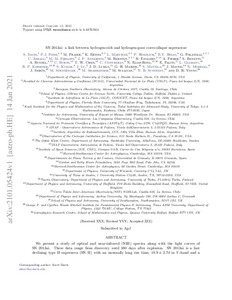SN 2013ai: A Link between Hydrogen-rich and Hydrogen-poor Core-collapse Supernovae
Davis S; Pessi PJ; Fraser M; Ertini K; Martinez L; Hoeflich P; Hsiao EY; Folatelli G; Ashall C; Phillips MM; Anderson JP; Bersten M; Englert B; Fisher A; Benetti S; Bunzel A; Burns C; Chen TW; Contreras C; Elias-Rosa N; Falco E; Galbany L; Kirshner RP; Kumar S; Lu J; Lyman JD; Marion GH; Mattila S; Maund J; Morrell N; Seron J; Stritzinger M; Shahbandeh M; Sullivan M; Suntzeff NB; Young DR
SN 2013ai: A Link between Hydrogen-rich and Hydrogen-poor Core-collapse Supernovae
Davis S
Pessi PJ
Fraser M
Ertini K
Martinez L
Hoeflich P
Hsiao EY
Folatelli G
Ashall C
Phillips MM
Anderson JP
Bersten M
Englert B
Fisher A
Benetti S
Bunzel A
Burns C
Chen TW
Contreras C
Elias-Rosa N
Falco E
Galbany L
Kirshner RP
Kumar S
Lu J
Lyman JD
Marion GH
Mattila S
Maund J
Morrell N
Seron J
Stritzinger M
Shahbandeh M
Sullivan M
Suntzeff NB
Young DR
IOP PUBLISHING LTD
Julkaisun pysyvä osoite on:
https://urn.fi/URN:NBN:fi-fe2021042826262
https://urn.fi/URN:NBN:fi-fe2021042826262
Tiivistelmä
We present a study of the optical and near-infrared (NIR) spectra of SN
2013ai along with its light curves. These data range from discovery
until 380 days after explosion. SN 2013ai is a fast declining Type II
supernova (SN II) with an unusually long rise time, 18.9 ± 2.7 days in
the V-band, and a bright V-band peak absolute magnitude of
−18.7 ± 0.06 mag. The spectra are dominated by hydrogen features in the
optical and NIR. The spectral features of SN 2013ai are unique in their
expansion velocities, which, when compared to large samples of SNe II,
are more than 1,000 km s−1 faster at 50 days past explosion.
In addition, the long rise time of the light curve more closely
resembles SNe IIb rather than SNe II. If SN 2013ai is coeval with a
nearby compact cluster, we infer a progenitor zero-age main-sequence
mass of ~17 M⊙. After performing light-curve modeling,
we find that SN 2013ai could be the result of the explosion of a star
with little hydrogen mass, a large amount of synthesized 56Ni, 0.3–0.4 M⊙, and an explosion energy of 2.5–3.0 × 1051
erg. The density structure and expansion velocities of SN 2013ai are
similar to those of the prototypical SN IIb, SN 1993J. However, SN
2013ai shows no strong helium features in the optical, likely due to the
presence of a dense core that prevents the majority of γ-rays
from escaping to excite helium. Our analysis suggests that SN 2013ai
could be a link between SNe II and stripped-envelope SNe.
2013ai along with its light curves. These data range from discovery
until 380 days after explosion. SN 2013ai is a fast declining Type II
supernova (SN II) with an unusually long rise time, 18.9 ± 2.7 days in
the V-band, and a bright V-band peak absolute magnitude of
−18.7 ± 0.06 mag. The spectra are dominated by hydrogen features in the
optical and NIR. The spectral features of SN 2013ai are unique in their
expansion velocities, which, when compared to large samples of SNe II,
are more than 1,000 km s−1 faster at 50 days past explosion.
In addition, the long rise time of the light curve more closely
resembles SNe IIb rather than SNe II. If SN 2013ai is coeval with a
nearby compact cluster, we infer a progenitor zero-age main-sequence
mass of ~17 M⊙. After performing light-curve modeling,
we find that SN 2013ai could be the result of the explosion of a star
with little hydrogen mass, a large amount of synthesized 56Ni, 0.3–0.4 M⊙, and an explosion energy of 2.5–3.0 × 1051
erg. The density structure and expansion velocities of SN 2013ai are
similar to those of the prototypical SN IIb, SN 1993J. However, SN
2013ai shows no strong helium features in the optical, likely due to the
presence of a dense core that prevents the majority of γ-rays
from escaping to excite helium. Our analysis suggests that SN 2013ai
could be a link between SNe II and stripped-envelope SNe.
Kokoelmat
- Rinnakkaistallenteet [27094]
